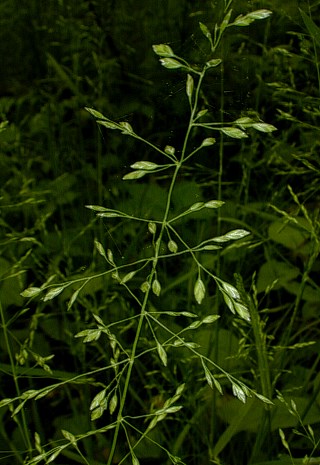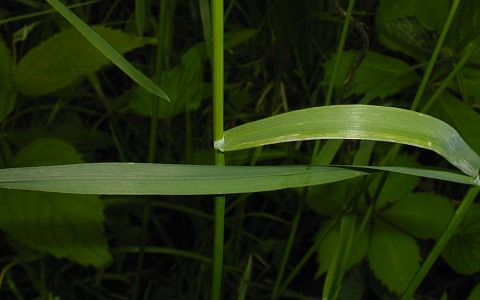Description:
This
grass is a loosely tufted perennial about 2-3' tall, sending up
several unbranched culms. Each culm has 4-5 alternate leaves along its
length; it is terete or slightly flattened, light green, and glabrous.
The leaf blades are up to 5" long and ¼" (6 mm.) across; they are
widely spreading or slightly drooping, dull green, and hairless. The
tips of the blades are keel-shaped, while their
margins are rough. The leaf sheaths are dull green,
hairless to minutely pubescent, and open. At the junction of each blade
and sheath, there is a white membranous ligule about 1-2 mm. long; it
is partially exerted above the blade. Each culm terminates in a panicle
of spikelets about 4-8" long and half as much across at the base; it is
pyramidal or conical in overall shape and airy in appearance. Along the
central axis (rachis) of each panicle, there are whorls of 3-5
branchlets that often subdivide into smaller branchlets. These
branchlets are slender, hairless, and widely spreading; as the
inflorescence ages, the lower branchlets often hang downward. At the
tip of each branchlet, there is a spikelet about 4 mm. long and 2 mm.
across that is somewhat flattened and light green; it consists of a
pair of glumes and 2-4 lemmas. The light green glumes are lanceolate
with membranous margins; the smaller glume is 1.5–2.0 mm. long, while
the larger glume is 2.5–3.0 mm. long. The light green to green lemmas
are lanceolate-oblong, and keeled; each lemma is about 3.0 mm. long
with 5 fine nerves (along the keel, both margins, and between the keel
and margins). These nerves are finely pubescent (at least along the
lower half of each lemma), while at the base of each lemma, there is
web of fine hairs. The blooming period occurs from late spring to early
summer. Shortly afterwards, this grass becomes yellow and fades away
during the summer. Then it forms low overwintering leaves during the
autumn. Each fertile lemma produces a single grain.
Disarticulation is above the glumes. The root system is fibrous; it
doesn't produce rhizomes or stolons. This grass occasionally forms
colonies by reseeding itself.
are keel-shaped, while their
margins are rough. The leaf sheaths are dull green,
hairless to minutely pubescent, and open. At the junction of each blade
and sheath, there is a white membranous ligule about 1-2 mm. long; it
is partially exerted above the blade. Each culm terminates in a panicle
of spikelets about 4-8" long and half as much across at the base; it is
pyramidal or conical in overall shape and airy in appearance. Along the
central axis (rachis) of each panicle, there are whorls of 3-5
branchlets that often subdivide into smaller branchlets. These
branchlets are slender, hairless, and widely spreading; as the
inflorescence ages, the lower branchlets often hang downward. At the
tip of each branchlet, there is a spikelet about 4 mm. long and 2 mm.
across that is somewhat flattened and light green; it consists of a
pair of glumes and 2-4 lemmas. The light green glumes are lanceolate
with membranous margins; the smaller glume is 1.5–2.0 mm. long, while
the larger glume is 2.5–3.0 mm. long. The light green to green lemmas
are lanceolate-oblong, and keeled; each lemma is about 3.0 mm. long
with 5 fine nerves (along the keel, both margins, and between the keel
and margins). These nerves are finely pubescent (at least along the
lower half of each lemma), while at the base of each lemma, there is
web of fine hairs. The blooming period occurs from late spring to early
summer. Shortly afterwards, this grass becomes yellow and fades away
during the summer. Then it forms low overwintering leaves during the
autumn. Each fertile lemma produces a single grain.
Disarticulation is above the glumes. The root system is fibrous; it
doesn't produce rhizomes or stolons. This grass occasionally forms
colonies by reseeding itself.
Cultivation:
This grass prefers dappled sunlight to light shade, moist to mesic
conditions, and a rich loamy soil. Most vegetative growth occurs during
the spring.
Range & Habitat:
Woodland Bluegrass is occasional throughout Illinois (see Distribution
Map), where it is native. Habitats include rich deciduous
woodlands, wooded
ravines, and rocky wooded slopes. This species is restricted to
woodlands where the original ground flora is still intact. It is the
most common woodland bluegrass in Illinois.
Faunal Associations:
While floral-faunal relationships for Poa spp.
(Bluegrasses) that grow in meadows are fairly well known, there is less
information available for woodland bluegrasses. However, the larvae of a moth, Elachista sylvestris, mine the leaves of Woodland Bluegrass during the spring when it is actively growing, while the larvae of another moth, Elachista albicapitella, mine the leaves of this grass during the winter (Braun, 1948; Needham et al., 1928). The foliage and seeds
of the latter are eaten by the Wild Turkey and Ruffed Grouse.
White-Tailed Deer tend to avoid woodland bluegrasses, preferring to
browse on broad-leaved forbs.
Photographic
Location:
A mesic area of Busey Woods in Urbana, Illinois.

Comments: While it is fairly large in size, this woodland bluegrass has a delicate appearance with airy panicles of spikelets. In general, the Poa spp. (Bluegrasses) are difficult to identify. Most guides distinguish different species of bluegrass by the appearance of their lemmas – in particular, the presence or absence of fine hairs at the base of the lemma and along its veins. This requires a hand lens with about 10x magnification, and even then it can be difficult to discern these hairs. In this regard, the lemmas of Woodland Bluegrass are hairier than most other species in this genus; each of its lemmas has fine hairs at the base and along all of the veins (at least along the lower half of the lemma). Some other distinguishing characteristics of this species include the following: 1) the blades of its leaves are wider (up to 6 mm.) than those of many other bluegrasses, and 2) the widely spreading branchlets of its panicles have a tendency to hang downward with age (particularly the lower ones). Other bluegrasses have branchlets that are ascending to spreading and they don't hang downward at maturity.